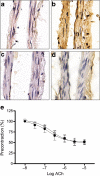Hyperglycaemia-induced impairment of endothelium-dependent vasorelaxation in rat mesenteric arteries is mediated by intracellular methylglyoxal levels in a pathway dependent on oxidative stress
- PMID: 20186387
- PMCID: PMC2850524
- DOI: 10.1007/s00125-010-1677-0
Hyperglycaemia-induced impairment of endothelium-dependent vasorelaxation in rat mesenteric arteries is mediated by intracellular methylglyoxal levels in a pathway dependent on oxidative stress
Abstract
Aims/hypothesis: Impaired nitric oxide (NO)-dependent vasorelaxation plays a key role in the development of diabetic vascular complications. We investigated the effect of hyperglycaemia on impaired vasoreactivity and a putative role therein of the AGE precursor methylglyoxal.
Methods: The effects of high glucose and methylglyoxal on NO-dependent vasorelaxation in isolated rat mesenteric arteries from wild-type and transgenic glyoxalase (GLO)-I (also known as GLO1) rats, i.e. the enzyme detoxifying methylglyoxal, were recorded in a wire myograph. AGE formation of the major methylglyoxal-adduct 5-hydro-5-methylimidazolone (MG-H1) was detected with an antibody against MG-H1 and quantified with ultra-performance liquid chromatography (tandem) mass spectrometry. Reactive oxygen species formation was measured with a 5-(and-6)-chloromethyl-2'7'-dichlorodihydrofluorescein diacetate acetyl ester probe and by immunohistochemistry with an antibody against nitrotyrosine.
Results: High glucose and methylglyoxal exposure of mesenteric arteries significantly reduced the efficacy of NO-dependent vasorelaxation (p < 0.05). This impairment was not observed in mesenteric arteries of GLO-I transgenic rats indicating a specific intracellular methylglyoxal effect. The diabetes-induced impaired potency (pD(2)) in mesenteric arteries of wild-type rats was significantly improved by GLO-I overexpression (p < 0.05). Methylglyoxal-modified albumin did not affect NO-dependent vasorelaxation, while under the same conditions the receptor for AGE ligand S100b did (p < 0.05). Methylglyoxal treatment of arteries increased intracellular staining of MG-H1 in endothelial cells and adventitia by fivefold accompanied by an eightfold increase in the oxidative stress marker nitrotyrosine. Antioxidant pre-incubation prevented methylglyoxal-induced impairment of vasoreactivity.
Conclusions/interpretation: These data show that hyperglycaemia-induced impairment of endothelium-dependent vasorelaxation is mediated by increased intracellular methylglyoxal levels in a pathway dependent on oxidative stress.
Figures






Similar articles
-
Glyoxalase-1 overexpression reduces endothelial dysfunction and attenuates early renal impairment in a rat model of diabetes.Diabetologia. 2014 Jan;57(1):224-35. doi: 10.1007/s00125-013-3088-5. Epub 2013 Oct 26. Diabetologia. 2014. PMID: 24162587
-
Uncoupling protein-2 protects endothelial function in diet-induced obese mice.Circ Res. 2012 Apr 27;110(9):1211-6. doi: 10.1161/CIRCRESAHA.111.262170. Epub 2012 Mar 29. Circ Res. 2012. PMID: 22461387
-
Methylglyoxal promotes oxidative stress and endothelial dysfunction.Pharmacol Res. 2012 May;65(5):497-506. doi: 10.1016/j.phrs.2012.03.004. Epub 2012 Mar 16. Pharmacol Res. 2012. PMID: 22425979
-
[The role of methylglyoxal metabolism in type-2 diabetes and its complications].Orv Hetil. 2012 Apr 15;153(15):574-85. doi: 10.1556/OH.2012.29348. Orv Hetil. 2012. PMID: 22472358 Review. Hungarian.
-
Methylglyoxal-Glyoxalase 1 Balance: The Root of Vascular Damage.Int J Mol Sci. 2017 Jan 18;18(1):188. doi: 10.3390/ijms18010188. Int J Mol Sci. 2017. PMID: 28106778 Free PMC article. Review.
Cited by
-
Habitual intake of dietary methylglyoxal is associated with less low-grade inflammation: the Maastricht Study.Am J Clin Nutr. 2022 Dec 19;116(6):1715-1728. doi: 10.1093/ajcn/nqac195. Am J Clin Nutr. 2022. PMID: 36055771 Free PMC article.
-
A Mechanism of Action of Metformin in the Brain: Prevention of Methylglyoxal-Induced Glutamatergic Impairment in Acute Hippocampal Slices.Mol Neurobiol. 2024 Jun;61(6):3223-3239. doi: 10.1007/s12035-023-03774-1. Epub 2023 Nov 18. Mol Neurobiol. 2024. PMID: 37980327
-
Methylglyoxal and Its Adducts: Induction, Repair, and Association with Disease.Chem Res Toxicol. 2022 Oct 17;35(10):1720-1746. doi: 10.1021/acs.chemrestox.2c00160. Epub 2022 Oct 5. Chem Res Toxicol. 2022. PMID: 36197742 Free PMC article. Review.
-
Calcitriol Supplementation Ameliorates Microvascular Endothelial Dysfunction in Vitamin D-Deficient Diabetic Rats by Upregulating the Vascular eNOS Protein Expression and Reducing Oxidative Stress.Oxid Med Cell Longev. 2021 Feb 2;2021:3109294. doi: 10.1155/2021/3109294. eCollection 2021. Oxid Med Cell Longev. 2021. PMID: 33623633 Free PMC article.
-
Nutraceutical Prevention of Diabetic Complications-Focus on Dicarbonyl and Oxidative Stress.Curr Issues Mol Biol. 2022 Sep 18;44(9):4314-4338. doi: 10.3390/cimb44090297. Curr Issues Mol Biol. 2022. PMID: 36135209 Free PMC article. Review.
References
-
- Makimattila S, Virkamaki A, Groop PH, et al. Chronic hyperglycemia impairs endothelial function and insulin sensitivity via different mechanisms in insulin-dependent diabetes mellitus. Circulation. 1996;94:1276–1282. - PubMed
-
- Diederich D, Skopec J, Diederich A, Dai FX. Endothelial dysfunction in mesenteric resistance arteries of diabetic rats: role of free radicals. Am J Physiol. 1994;266:H1153–H1161. - PubMed
-
- Pflueger AC, Osswald H, Knox FG. Adenosine-induced renal vasoconstriction in diabetes mellitus rats: role of nitric oxide. Am J Physiol. 1999;276:F340–F346. - PubMed
Publication types
MeSH terms
Substances
LinkOut - more resources
Full Text Sources
Other Literature Sources
Medical
Research Materials
Miscellaneous

